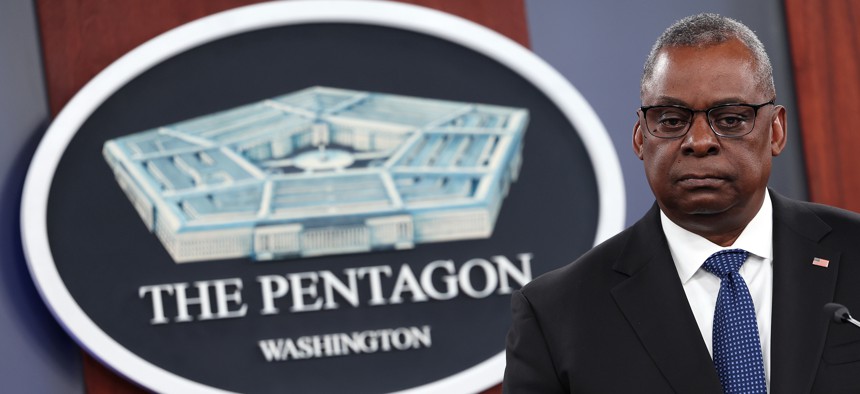
U.S. Secretary of Defense Lloyd Austin holds a media briefing at the Pentagon on October 27, 2022 in Arlington, Virginia. Kevin Dietsch/Getty Images
That’s it? Biden’s Overdue Pentagon Strategy Underwhelms
After nearly two years, experts were hoping for more.
Delayed by Russia’s invasion of Ukraine, the Biden administration’s Pentagon policy team finally released their first National Defense Strategy. It arrives just two weeks after the White House’s broader National Security Strategy, and in conjunction with the nearly-as-important nuclear and missile defense strategies—one PDF to rule them all.
The result is that we can now see on paper the administration’s thinking behind what was already largely in practice at the Pentagon anyway: China is a “pacing challenge,” Russia is an “acute threat,” and the United States will keep building and improving its nuclear umbrella and missile defenses.
But not there’s not much more than that in this NDS, and that’s troublesome.
Look, a strategy is not a detailed budget with operational plans. It’s a think-tank Ph.D.’s dream assignment. On Thursday, Defense Secretary Lloyd Austin called the NDS “our department’s North Star.” But the world is changing before our eyes and two years into the Biden era, after four years of the Trump administration’s hodgepodge Pentagon teams of amateurs and empty desks, today’s national security experts have been eagerly expecting more. They anticipated from this administration’s team of well-groomed rising scholars a strategy document that reflects a bold new vision for a new world of threats, but also one that comes with some major action items or directions to reorient the entire defense apparatus.
Instead, the Pentagon’s arguably most important document outside of the budget request is little more than a boiled-down reduction of every speech and press conference that Biden administration officials have given in nearly two years since taking office. In it, Biden officials note the threats and broad challenges that any security leader working in this field already knows. And they declare that the U.S. defense “ecosystem,” from industry to academics, must evolve to meet new threats and keep ahead of the latest adversaries, which is a noble but very stale pronouncement for any president’s Pentagon team.
Biden critics will likely to be pleased to see China and Russia listed first among strategic threats, followed by threats to the homeland—although they mean missiles, not migrants—North Korea, Iran, terrorists groups, and grey-zone challenges. Climate change comes last.
“The PRC is the only competitor with both the intent to reshape the international order and increasingly the power to do so. Now, my team and I have been laser-focused on this from day one,” Austin said, reminding us of what we knew. The secretary read through the threat list, declared the Pentagon would realign its efforts—more than it already is, presumably—and address them with “a military ready to tackle the full range of threats out there, harnessing the American spirit of innovation to meet the complexities of today’s world.” He took a few questions and disappeared after about 20 minutes.
In all, while the Biden NDS paints a broad picture of the Pentagon of the future, what’s missing is a clear view of how the administration plans to get from here to there. Instead, we got an academic word salad that put so much lipstick on this pig it’s unnecessarily masking the good bacon waiting inside.
For instance, the NDS says it will advance its goals—something is “advancing” 19 times in this slog—through oddly worded phrases like the administration’s preferred “integrated deterrence,” which appears to mean the same thing as “whole of government.” To clarify what integrated deterrence means, they write: “Tailored to specific circumstances, it applies a coordinated, multifaceted approach to reducing competitors’ perceptions of the net benefits of aggression relative to restraint.” Eat your heart out, Shakespeare.
They then promise to do the NDS-ing via some “campaigning,” which from my reading means just doing the work, but across the whole of government.
Where the NDS writers finally show some leg is the third and final passage: “we will act urgently to build enduring advantages across the defense ecosystem.”
If only they’d just said so. This is perhaps the part that matters most. “Our current system is too slow and too focused on acquiring systems not designed to address the most critical challenges we now face. This orientation leaves little incentive to design open systems that can rapidly incorporate cutting-edge technologies, creating longer-term challenges with obsolescence, interoperability, and cost effectiveness. The Department will instead reward rapid experimentation, acquisition, and fielding.”
That’s music to the defense industry’s ears, but it is also not new. It’s sadly ironic that this promise comes two days after the death of former Defense Secretary Ash Carter, who made those same declarations years ago. While it reflects his legacy, it left outside experts shaking their heads and wanting more.
Seth Jones, senior vice president at Center for Strategic and International Studies and director of its International Security Program, said there is “a gap between what the National Defense Strategy says and what the U.S. is prepared for. This really is an industrial base that, at least in my judgment, is in no way fully prepared to fight, let alone deter, the Chinese.” Jones said the document describes the China threat well enough. “What’s left, though, is what are we going to do about it?”
Also missing from the NDS is an admission or acknowledgement of what many experts insist the Ukraine war has exposed: that the United States—especially the American defense industrial base—is not ready, positioned, or stocked well enough to win large wars.
“The war in Ukraine, I think as all of us are aware, exposed deficiencies in the U.S. defense industrial base [and] did the same thing with our European partners and allies,” Jones said.
“If we look at the roughly two dozen iterations of a war game in the Taiwan Strait…the U.S. expended all of its joint air-to-surface standoff missiles and long-range precision guided anti-ship missiles within the first week of the conflict. And we’ve seen similar war games done by government agencies,” he said.
It’s unclear from the NDS just how much the Ukraine war, and Russia’s weaker-than-expected military performance, changed the Biden administration’s plans for the Pentagon.
One senior defense official who worked on the strategies but was not allowed to speak on the record told reporters in a Pentagon-arranged briefing that NDS planners knew that Russia was likely to invade Ukraine in early autumn 2021, so that assumption was already “baked into” their thinking as they crafted the new strategy.
But a second senior defense official, also not allowed to show their face or be named, said of Russia’s persistent nuclear threats: “I wouldn’t say it changes our calculus, but it does focus the mind.”
That’s not good enough for some experts looking out for their own areas of interest. Tom Karako, senior fellow at CSIS’s International Security Program and director of its Missile Defense Project, had mixed feelings about the administration’s updated missile defense review within the NDS. “We’ve got these really great new mission areas that I applaud—defense of Guam, counter-UAS, homeland cruise missile defense, hypersonic defense, space sensors. But there’s no specificity for when they will arrive, which, I have to say, is a little bit peculiar because the first sentence of the National Defense Strategy is—and repeatedly you see reference to—the ‘decisive decade.’ Well, the question is, will these great capabilities—be it missile defense, be it something else—will they arrive during this decisive decade, or will they be pushed off to the next decade?”
Karako also bemoaned the lack of strategic guidance about producing more key capabilities like air defenses. “It deserves policy guidance and direction, which is the aim of the NDS.”
Of course, every team of Pentagon leaders has to make choices some won’t like. A string of Pentagon teams over the past decade has been criticized for their unwillingness to take risks that prioritize immediate threats over less likely ones in the distant future. That was harder when the future was less certain after Iraq and Afghanistan. Today the future seems a bit clearer, with easily identifiable threats emanating from Moscow and Beijing. What no NDS can prepare for, however, is that other Pentagon cliché: the enemy gets a vote.
So while it is encouraging that Biden’s NDS at least promises to favor the quick, it’s hard to see how this strategy would have been much different had it been released in January, or sooner. Perhaps it would have overestimated Russia’s capabilities or China’s resolve. If anything, Biden’s team has lost valuable time because while they were undergoing this academic exercise, important as it may be, they have been reacting to a threat landscape that has been arguably shaped more by Vladimir Putin and Xi Jinping than their own hand. They will need to be as nimble and quick as they profess in this document. By waiting until now to issue these guiding strategies at the White House and Pentagon, President Joe Biden’s team has given the United States less than three months to do anything about them before he likely faces a hostile Congress run by extreme-right Republicans. Biden has just two years left in this administration to change the world. Putin and Xi have far longer.
NEXT STORY: Ash Carter’s Lasting Legacy
